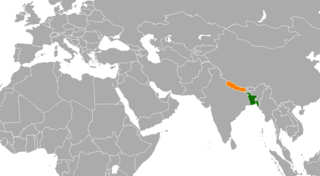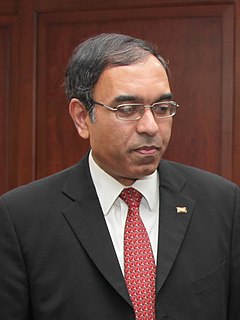
India has diplomatic relations with 201 states/dependencies around the globe, having 199 missions and posts operating globally while plans to open new missions in 2020–21 hosted by 11 UN Member States.

Though the Ministry of Foreign Affairs (MOFA) is the government agency responsible for the conduct of foreign relations of Nepal, historically, it is the Office of Prime Minister (PMO) that has exercised the authority to formulate and conduct policies related to Nepal's foreign affairs. As a landlocked country wedged between two larger and far stronger powers, Nepal has tried to maintain good relations with both of its neighbors, People's Republic of China and Republic of India. Nepal's relationship with China, India, and the USA has remained utmost priority for successive Nepali governments. The relationship between Nepal and India however was significantly hampered during the 2015 Nepal blockade by pro-Indian anti-Nepal protestors, where the Government of Nepal accused India of using "Russia-Ukraine" tactics to cause unrest along Nepal's southern border using ethnically Indian residents of Nepal. India strictly denied the allegation and said the unrest were solely due to Madheshi protesters. For the most part though, Nepal has traditionally maintained a non-aligned policy and enjoys friendly relations with its neighboring countries and almost all the major countries of the world.

The South Asian Association for Regional Cooperation (SAARC) is the regional intergovernmental organization and geopolitical union of states in South Asia. Its member states are Afghanistan, Bangladesh, Bhutan, India, Maldives, Nepal, Pakistan, and Sri Lanka. SAARC comprises 3% of the world's land area, 21% of the world's population and 5.21% of the global economy, as of 2021.

The Bay of Bengal Initiative for Multi-Sectoral Technical and Economic Cooperation (BIMSTEC) is an international organisation of seven South Asian and Southeast Asian nations, housing 1.73 billion people and having a combined gross domestic product of US$4.4 trillion (2022). The BIMSTEC member states – Bangladesh, Bhutan, India, Myanmar, Nepal, Sri Lanka, and Thailand – are among the countries dependent on the Bay of Bengal.

Nepal–Pakistan relations refer to the bilateral relations between Nepal and Pakistan, both Himalayan states located on the Indian subcontinent. After the Partition of British India in August 1947, Nepal moved to establish diplomatic relations with the Dominion of India, but did not do so with the Dominion of Pakistan. Official diplomatic ties did not exist between the two states until initial steps were taken on 29 March 1960; these relations were then fully established between 1962 and 1963. Both nations have since sought to expand their bilateral trade, strategic and military cooperation. In 1972, following Pakistan's defeat in the Bangladesh Liberation War and the secession of East Pakistan as the People's Republic of Bangladesh, Nepal recognized the latter's independence. Pakistan severed ties with Nepal shortly afterwards, but these were later re-established.
The South Asian Regional Trade Union Council (SARTUC) is a federation of national trade union centers whose geographic scope covers South Asia. SARTUC's mission is to promote workers' rights within its member nations.

South Asia is the southern region of Asia, which is defined in both geographical and ethno-cultural terms. The region consists of the countries of Afghanistan, Bangladesh, Bhutan, India, Maldives, Nepal, Pakistan, and Sri Lanka. Topographically, it is dominated by the Indian Plate and defined largely by the Indian Ocean on the south, and the Himalayas, Karakoram, and Pamir mountains on the north. The Amu Darya, which rises north of the Hindu Kush, forms part of the northwestern border. On land (clockwise), South Asia is bounded by Western Asia, Central Asia, East Asia, and Southeast Asia.

The Asia-Pacific Trade Agreement (APTA), previously known as the Bangkok Agreement and renamed 2 November 2005, was signed in 1975. It is the oldest preferential trade agreement between countries in the Asia-Pacific region. The APTA covers market for 2921.2 million people [2] which accounts for US$14615.86 billion in terms of gross domestic product (GDP) in the Fiscal Year (FY) 2015-2016. APTA’s key objective is to hasten economic development among the seven participating states opting trade and investment liberalization measures that will contribute to intra-regional trade and economic strengthening through the coverage of merchandise goods and services, synchronized investment regime and free flow of technology transfer making all the Participating States to be in equally winsome situation. Its aim is to promote economic development and cooperation through the adoption of trade liberalization measures. APTA is open to all members of the United Nations Economic and Social Commission for Asia and the Pacific, which serves as the APTA Secretariat. Members of APTA are currently participating in the Fourth Round of Tariff Concessions, which are expected to conclude in October 2009.

The bilateral relations between the People's Republic of Bangladesh and the Federal Democratic Republic of Nepal have been progressive since the foundation of Bangladesh in 1971. The two nations are separated by the "Siliguri Corridor" - a 22 kilometres (14 mi) wide stretch of territory of the Indian state of West Bengal lies between southern Nepal and northern Bangladesh. Both South Asian nations are members of the South Asian Association for Regional Cooperation (SAARC) and Bay of Bengal Initiative for MultiSectoral Technical and Economic Cooperation (BIMSTEC).
The SAARC Baseball Championship is the main championship tournament between national baseball teams in South Asia. It is governed by the Baseball Federation of Asia (BFA). The first championship tournament began on 12 April 2011 and was hosted in Lahore, Pakistan. Four international teams from South Asia participated, including Nepal, Sri Lanka and Afghanistan.

Secretary-General of the South Asian Association for Regional Cooperation, is head of a SAARC Secretariat, which is headquartered in Kathmandu, Nepal. SAARC is an economic and geopolitical union between the eight South Asian member nations, Afghanistan, Bangladesh, Bhutan, India, Maldives, Nepal, Pakistan and Sri Lanka. Secretary-General is appointed for a three-year term by election by a council of Ministers from member states. Secretary-General is assisted by eight deputies, one from each nation, who also reside in Kathmandu. SAARC Secretariat was established in Kathmandu on 16 January 1987 by Bangladeshi diplomat Abul Ahsan, who was its first Secretary-General, and was inaugurated by King Birendra Bir Bikram Shah of Nepal. Since its creation, its member nations have contributed to a total of fourteenth General Secretaries. Sri Lanka's diplomat Esala Weerakoon is the current Secretary-General, having assumed charge on 1 March 2020.
The eighteenth summit of 'South Asian Association of Regional Cooperation' (SAARC) was held in Kathmandu, the capital of Federal Democratic Republic of Nepal during 26–27 November 2014. The theme of the summit was Deeper Integration for Peace and Prosperity, focused on enhancing connectivity between the member states for easier transit-transport across the region. Sushil Koirala, the then Nepalese Prime Minister, was the main host of the event which took place in Rastriya Sabha Griha The summit took place after an interval of three years as the previous summit was held in 2011 in Maldives.
Declaration of 18th SAARC Summit was made during SAARC Summit 2014 in Nepal.The 18th SAARC summit was held in Kathmandu, Nepal from 26 to 27 November 2014. The state heads of eight SAARC member countries along with their delegations had meeting during the Summit and discussed the agendas of SAARC. The discussions on previous implementations was made by the delegations before the summit. They Recognized that after nearly thirty years of their existence, it was time to reinvigorate SAARC's regional cooperation and revitalize SAARC as an effective vehicle to fulfill the developmental aspirations of the peoples of South Asia; Determined to deepen regional integration for peace and prosperity by promoting mutual trust, amity, understanding, cooperation and partnership;the 18th SAARC summit Declaration was made.
The 19th SAARC summit was a scheduled diplomatic conference, which was originally planned to be held in Islamabad, Pakistan on 15–19 November 2016 but got cancelled after an attack on Indian army camp in Kashmir. The summit was to be attended by the leaders of the eight SAARC member states and representatives of observers and guest states.

Neighbourhood First Policy of India, a core component of India's foreign policy, focuses on peaceful relations and collaborative synergetic co-development with its South Asian neighbors of the Indian subcontinent encompassing a diverse range of topics, such as economic, technology, research and education, connectivity, space program, defence security, environment and climate challenge. This policy creates new avenues as well as leverages existing regional cooperation initiatives, such as SAARC, SASEC, BBIN, and BIMSTEC. It compliments India's Look East policy focused on Southeast Asia and Look West Policy focused on Middle East.

The South Asia Satellite, formerly known as SAARC Satellite, is a geostationary communications and meteorology satellite operated by the Indian Space Research Organisation for the South Asian Association for Regional Cooperation (SAARC) region. The satellite was launched on 5 May 2017. During the 18th SAARC summit held in Nepal in 2014, Indian Prime Minister Narendra Modi mooted the idea of a satellite serving the needs of SAARC member nations as a part of his neighbourhood first policy. Afghanistan, Bangladesh, Bhutan, Maldives, Nepal and Sri Lanka are the users of the multi-dimensional facilities provided by the satellite.

The Bangladesh, Bhutan, India, Nepal (BBIN) Initiative is a subregional architecture of countries in Eastern South Asia, a subregion of South Asia. It meets through official representation of member states to formulate, implement and review quadrilateral agreements across areas such as water resources management, connectivity of power, transport, and infrastructure.

South Asia Foundation (SAF) was founded by UNESCO Goodwill Ambassador Madanjeet Singh in 2000. The South Asia Foundation (SAF) is a secular, non-profit and non-political organization, comprising eight autonomous chapters: Afghanistan, Bangladesh, Bhutan, India, Maldives, Nepal, Pakistan and Sri Lanka.

Countries and territories in South Asia have been affected by the COVID-19 pandemic. The first South Asian country to report a confirmed case was Nepal, which documented its first case on 23 January 2020, in a man who had returned from Wuhan on 9 January. As of 2 July, at least one case of COVID-19 has been reported in every country in South Asia. Afghanistan, Bangladesh, Pakistan and Maldives have implemented lockdowns, Sri Lanka has responded with quarantine curfews while India and Nepal have declared a country-wide lockdown. Countries have also instituted various levels of restrictions on international travel, some countries have completely sealed off their land borders and grounded most international flights.














